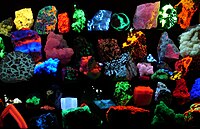
Photo from wikipedia
Purely organic small molecules with thermally-activated delayed fluorescence have a high potential for application in organic light-emitting diodes (OLEDs), but overcoming severe efficiency roll-off at high voltages still remains challenging.… Click to show full abstract
Purely organic small molecules with thermally-activated delayed fluorescence have a high potential for application in organic light-emitting diodes (OLEDs), but overcoming severe efficiency roll-off at high voltages still remains challenging. In this work, we design and synthesize two new emitters consisting of electron-withdrawing benzoyl and electron-donating phenoxazine and 9,9-dihexylfluorene. Their electronic structures, thermal stability, electrochemical behaviors, photoluminescence property, and electroluminescence performance are thoroughly investigated. These new emitters show weak fluorescence in dilute solution, but they can emit strongly with prominent delayed fluorescence in the aggregated state, indicating the aggregation-induced delayed fluorescence (AIDF) character. The solution-processed OLEDs based on the two emitters show high external quantum efficiency of 14.69%, and the vacuum-deposited OLEDs can also provide comparable external quantum efficiency of 14.86%. Significantly, roll-offs of the external quantum efficiencies are very small (down to 0.2% at 1,000 cd m−2) for these devices, demonstrating the evidently advanced efficiency stability. These results prove that the purely organic emitters with AIDF properties can be promising to fabricate high-performance solution-processed OLEDs.
Journal Title: Frontiers in Chemistry
Year Published: 2020
Link to full text (if available)
Share on Social Media: Sign Up to like & get
recommendations!